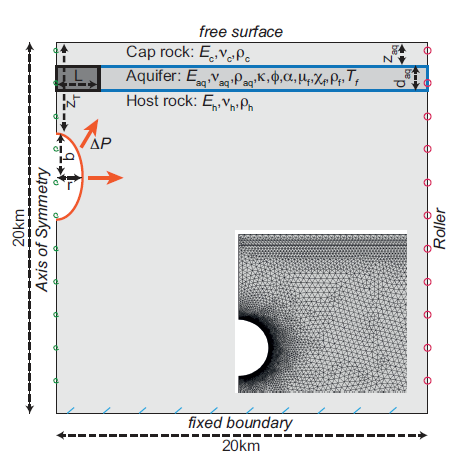Words on Wednesday aims at promoting interesting/fun/exciting publications on topics related to Energy, Resources and the Environment. If you would like to be featured on WoW, please send us a link of the paper, or your own post, at ERE.Matters@gmail.com.
***
Strehlow, K., Gottsmann, J. H., and Rust, A. C., 2015. Poroelastic responses of confined aquifers to subsurface strain changes and their use for volcano monitoring, Solid Earth Discuss., 7, 1673-1729, doi:10.5194/sed-7-1673-2015.
Abstract:
Well water level changes associated with magmatic unrest can be interpreted as a result of pore pressure changes in the aquifer due to crustal deformation, and so could provide constraints on the subsurface processes causing this strain. We use Finite Element Analysis to demonstrate the response of aquifers to volumetric strain induced by pressurised magma reservoirs. Two different aquifers are invoked – an unconsolidated pyroclastic deposit and a vesicular lava flow – and embedded in an impermeable crust, overlying a magma chamber. The time-dependent, fully coupled models simulate crustal deformation accompanying chamber pressurisation and the resulting hydraulic head changes as well as porous flow in the aquifer. The simulated deformational strain leads to centimetres (pyroclastic aquifer) to meters (lava flow aquifer) of hydraulic head changes; both strain and hydraulic head change with time due to substantial porous flow in the hydrological system. Well level changes are particularly sensitive to chamber volume and shape, followed by chamber depth and the phase of the pore fluid. The Young’s Modulus and permeability of the aquifer, as well as the strength of pressurisation also have significant influence on the hydraulic head signal. While source characteristics, the distance between chamber and aquifer and the elastic stratigraphy determine the strain field and its partitioning, flow and coupling parameters define how the aquifer responds to this strain and how signals change with time. We investigated a period of pre-eruptive head changes recorded at Usu volcano, Japan, where well data were interpreted using an analytical deformation model. We find that generic analytical models can fail to capture the complex pre-eruptive subsurface mechanics leading to well level changes, due to aquifer pressure changes being sensitive to chamber shape and lithological heterogeneities. In addition, the presence of a pore fluid and its flow have a significant influence on the strain signal in the aquifer and are commonly neglected in analytical models. These findings highlight the need for numerical models for the interpretation of observed well level signals. However, simulated water table changes do mirror volumetric strain and wells can therefore serve as comparatively cheap strain meters that could provide important insights into pre-eruptive dynamics.

2-D axisymmetric model setup: a boundary load dP is applied on a cavity at depth, with the radius r for the spherical case or vertical semi-axis b for the ellipsoidal case, respectively. This changes the strain conditions in the surrounding linear elastic host rock (granitic crust), the poroelastic aquifer and the overlying linear elastic cap rock (clay). The watersaturated aquifer is modelled as either a vesicular lava flow or unconsolidated pyroclasts. An aquifer not covering the chamber but starting at some lateral distance L is realised by setting the darker grey region impermeable. The bottom boundary is fixed, the upper boundary is treated as a free surface, the lateral boundaries have a roller condition. There is no flow outside the aquifer, stress and displacement at the internal boundaries are continuous. An extract of the finite element mesh is shown only for illustration. The mesh density is finer around the cavity, at aquifer boundaries and the free surface.
